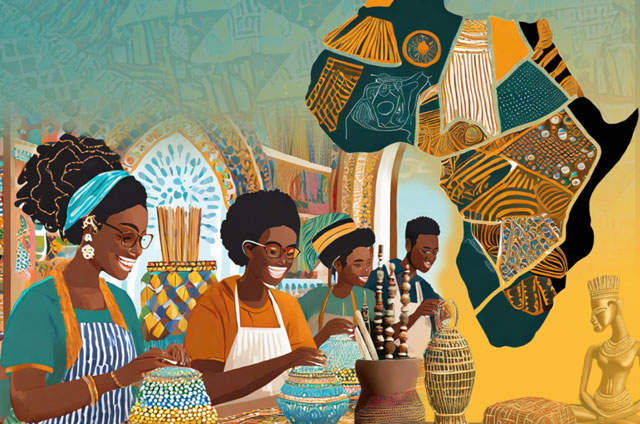
The list provides a glimpse into the remarkable diversity and vibrancy of African crafts, highlighting just a few examples from the continent’s rich artistic heritage.
SPECIAL REPORT | BIRD AGENCY | Africa’s artistic tapestry is as diverse as its people. Africans breathe life into art and craft, with every stroke of the brush or mark of a chisel telling a story of resilience, heritage and boundless imagination.
As we embark on this artistic odyssey, remember that Africa’s creativity knows no bounds. From ancient doors that hold secrets to the delicate strokes of a master potter, each country on this list adds its unique hue to the continent’s vibrant palette.
1. Nigeria: Known for its bronze sculptures, Adire textiles, and beaded jewellery.
Bronze lost-wax sculpture harks back hundreds of years, to the Kingdom of Benin. Where sculpture can serve as a link to the past, offering up a dynastic record and reflecting the spiritual beliefs and cultural practices of a range of ethnicities, Adire textiles stand out as a single ethnicity’s invention. Adire is a traditional Yoruba textile art made in southwestern Nigeria by Yoruba women. It involves a variety of resist-dyeing techniques, resulting in patterned designs with vibrant arrays of tints and hues. Beadwork is an integral part of Nigerian culture, especially among various ethnic groups. Nigerian artisans create stunning beaded jewellery using a wide range of materials, including glass beads, coral, and semi-precious stones.
2. Ghana: Famous for its Kente cloth, black pottery, and Adinkra symbols
Kente is a handwoven fabric originating from the Ashanti people of Ghana. It is characterized by its intricate patterns and vibrant colours. Black pottery is another remarkable aspect of Ghanaian craftsmanship. The pottery is created using a unique technique that results in a distinct black colour. The pottery is often adorned with traditional motifs and symbols, reflecting the culture and beliefs of the local communities. Adinkra symbols are visual representations with deep historical and philosophical significance. Originally printed on cloth, these symbols were worn by royals during important ceremonies. The Gyaman people of Ghana and Côte d’Ivoire are credited with their origin.
3. Morocco: Renowned for its Zellige tiles, carpets, and metalwork
Zellige tiles are handcrafted geometric ceramic tiles, traditionally made in Morocco. They are used in interior and exterior spaces, adding elegance to walls, floors and much more. Moroccan carpets, also known as Berber carpets, hold cultural significance. The carpets are typically made from natural fibres like wool and camel hair. Intricate metalwork such as ornate metal teapots and trays are part of Moroccan tea culture and are a source of pride for craftspeople who work with brass, copper, and silver.
4. South Africa: Its diverse crafts include beadwork, textiles, and basketry
Whether you’re drawn to the intricate beadwork, the organic textures of basketry, or the vibrant textiles, South Africa’s crafts offer a glimpse into its rich heritage and creativity.
5. Kenya: Recognized for its basketry, woodcarvings, and beadwork
When people mention Kenya, the first thing that comes to mind is its wildlife and safaris but this country has cultural and artistic treasures that represent a particularly diverse heritage and history. The Kamba, Giriama, and Turkana ethnic groups of Kenya are known for their beadwork, basketry, and carvings. They often use bright colours and intricate patterns in their art. One can find these crafts in markets or through online digital shops.
6. Senegal: Known for its textiles, jewellery, and masks.
Senegal’s vibrant arts scene, lively cities like Dakar and its blend of tradition and modernity make it a fascinating destination for travellers and art enthusiasts alike. Often referred to as the “Gateway to Africa.” Senegal’s rich cultural heritage is influenced by several distinct ethnic groups, including the Wolof, Fulani, Serer, Diola, and Malinke.
7. Ethiopia: Renowned for its textiles, metalwork, and coffee ceremony equipment.
The intricate patterns of textiles, vivid colours, and symbolic motifs reflect the country’s diverse ethnic groups. Shemma (a white cotton wrap) and Netela (a lightweight scarf) are some examples of iconic Ethiopian garments. skilled artisans create intricate jewellery, crosses, and other decorative items using techniques passed down through generations. The cross pendants worn by Ethiopian Orthodox Christians are particularly striking, featuring unique designs and religious symbolism. These crosses are often made from silver or brass. The Ethiopian coffee ceremony, locally known as “buna tetu,” is a time-honoured tradition that celebrates Ethiopia’s status as the birthplace of coffee. It’s not just about sipping a cup of joe; it’s a deeply cultural and social event.
8. Rwanda: Recognized for Imisango baskets, Amasho pottery, and Agaseke painting
Imisango refers to beautifully woven baskets made by Rwandan artisans. They are crafted using locally available fibres. They serve both functional and aesthetic purposes, often used for storage, carrying goods, or as decorative pieces. Each tells a unique story reflecting the weaver’s creativity. Amasho pottery features uniquely shaped vessels, pots, and other ceramic objects while Agaseke baskets are a unique type of Rwandan basket made from cow dung and natural fibres. They have a flat circular base that is taller than it is wide, with a sloped conical fitted lid. The intricate patterns are made using natural green, black, yellow and red dyes.
9. Mali: Famous for its Earthen architecture, Bògòlanfini mudcloth, N’domo carved doors, and jewellery
The craft of building with earth is most famously represented by the Djenne Mosque but there is a lot more to Malian crafts. Bògòlanfini, also known as mud cloth, is a handmade cotton fabric that undergoes a unique dyeing process using fermented mud. N’domo carved doors are named after a secret society among the Bamana people. The intricately carved wooden doors feature symbolic motifs and serve as gateways to spiritual knowledge and growth. Fulani gold earrings, Tuareg silver pendants and bracelets are prized worldwide.
10. Zimbabwe: Recognized for its Shona sculptures, baskets, and beadwork
Shona soapstone sculptures are highly regarded (and collected) worldwide due to their expressive forms and reflection of nature. The Shona are Zimbabwe’s largest ethnic group followed by the Ndebele who contribute to beadwork crafts, an integral part of Zimbabwean culture. The baskets woven in the country serve practical purposes, such as storage and carrying goods, but they also hold cultural significance as an art form passed down from generation to generation.
****
SOURCE: Fiske Nyirongo, bird story agency
 The Independent Uganda: You get the Truth we Pay the Price
The Independent Uganda: You get the Truth we Pay the Price


